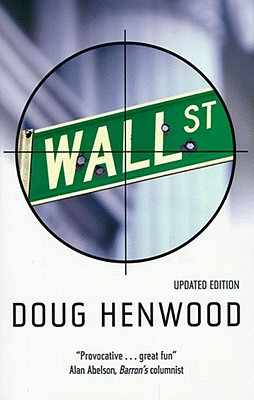Wall Street: How It Works and for Whom
Doug Henwood

I started reading this book because I’ve been reading some left-leaning econ bloggers (Josh Mason, Mike Konczal) and ran across mention of Henwood and this book a few times.
Make no mistake, “Wall Street” is a hard-left leaning book. It was definitely an interesting read, especially because it was written in the mid-90s. I give DH a lot of credit: today, it’s relatively acceptable to argue that the financial system does not allocate capital optimally, since the wreckage is staring us in the face; in the mid-90s, during the early boom years of the New Economy, it certainly took a lot more courage. I also give DH credit for being into Hyman Minsky before it was cool to be into Hyman Minsky.
The most interesting part of this book for me was its discussion of the economic and societal role of the stock market. Econ 101 tells us that the function of the stock market is to allocate capital to real-economy enterprises. DH (along with Mason and others) argues that this is not really the case, that firms empirically fund most capital investment out of internal funds, and that stock markets mainly serve as a source of liquidity for existing owners of capital. Although DH is making his argument in a journalistic style and not a rigorous academic form, this view is certainly supported by the recent IPO plans of Groupon, LinkedIn, and Facebook, which all have publicly stated that they do not need the cash but would like to give their existing equity holders a liquid market that they can use to mark the value of their holdings or to exit. This function is still, of course, related to capital allocation, just like an exhaust system affects the performance of a car engine, but the connection may be much less direct than the Econ 101 picture would lead us to believe. Also, in a world with Shleifer-Vishny limits to arbitrage, we may only be able to hold the weak efficient markets hypothesis (or what Rajiv Sethi prefers to call the Invincible Markets Hypothesis), which says that it’s impossible to beat the market, but not that the market correctly values real-world assets–meaning that it may not be an efficient allocator of capital even when used as such. (If you don’t agree, there is a subdivision in Nevada that I’d like to sell you.)
Another thing that DH highlights is the extreme concentration of the holdings of financial assets in the top of the income/wealth distribution. Oftentimes, policies that benefit holders of financial assets are promoted using the argument that “Hey, almost everyone owns some stock.” While that may be true, the reality is that the vast inequality in holdings means that any policy supporting financial assets has an extremely regressive impact.
All that said, I didn’t love the book. DH is often too facile with his examples–for instance, holding up Japanese keiretsu as an example of more equitable economic organization (is a cartel really better for the little guy?). There is also a fairly long Freudian digression which I found completely bizarre and off-putting.